Related Research Articles

Honorius was Roman emperor from 393 to 423. He was the younger son of emperor Theodosius I and his first wife Aelia Flaccilla. After the death of Theodosius in 395, Honorius, under the regency of Stilicho, ruled the western half of the empire while his brother Arcadius ruled the eastern half. His reign over the Western Roman Empire was notably precarious and chaotic. In 410, Rome was sacked for the first time since the Battle of the Allia almost 800 years prior.
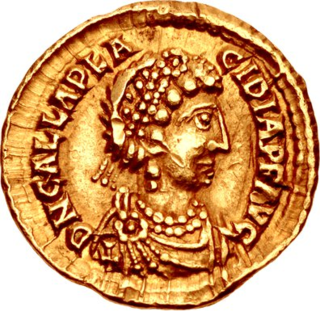
Galla Placidia, daughter of the Roman emperor Theodosius I, was a mother, tutor, and advisor to emperor Valentinian III. She was queen consort to Ataulf, King of the Visigoths from 414 until his death in 415, briefly empress consort to Constantius III in 421, and managed the government administration as a regent during the early reign of Valentinian III until her death.

Year 410 (CDX) was a common year starting on Saturday of the Julian calendar. At the time, it was known as the Year after the Consulship of Honorius and Theodosius. The denomination 410 for this year has been used since the early medieval period, when the Anno Domini calendar era became the prevalent method in Europe for naming years.

Year 412 (CDXII) was a leap year starting on Monday of the Julian calendar. At the time, it was known in Europe as the Year of the Consulship of Honorius and Theodosius. The denomination 412 for this year has been used since the early medieval period, when the Anno Domini calendar era became the prevalent method in Europe for naming years.

Year 414 (CDXIV) was a common year starting on Thursday of the Julian calendar. At the time, it was known as the Year of the Consulship of Constantius and Constans. The denomination 414 for this year has been used since the early medieval period, when the Anno Domini calendar era became the prevalent method in Europe for naming years
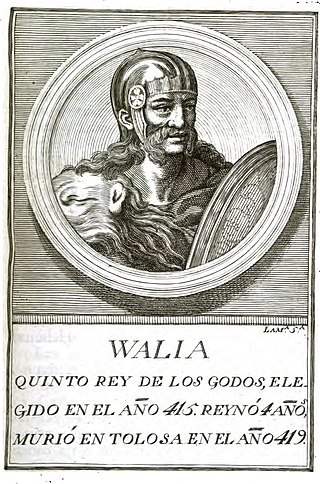
Year 415 (CDXV) was a common year starting on Friday of the Julian calendar. At the time, it was known as the Year of the Consulship of Honorius and Theodosius. The denomination 415 for this year has been used since the early medieval period, when the Anno Domini calendar era became the prevalent method in Europe for naming years.
The 410s decade ran from January 1, 410, to December 31, 419.
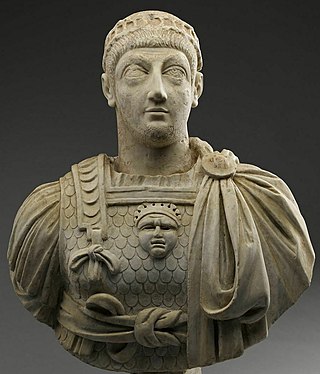
Valentinian III was Roman emperor in the West from 425 to 455. Starting in childhood, his reign over the Roman Empire was one of the longest, but was dominated by civil wars among powerful generals and the invasions of late antiquity's Migration Period.

Constantius III was briefly Western Roman emperor in 421, having earned the throne through his capability as a general under Honorius. By 411 he had achieved the rank of magister militum, and in the same year he suppressed the revolt of the usurper Constantine III. Constantius went on to lead campaigns against various barbarian groups in Hispania and Gaul, recovering much of both for the Western Roman Empire. He married Honorius's sister Galla Placidia in 417, a sign of his ascendant status, and was proclaimed co-emperor by Honorius on 8 February 421. Constantius reigned for seven months before dying on 2 September 421.
Wallia, Walha or Vallia, was king of the Visigoths from 415 to 418, earning a reputation as a great warrior and prudent ruler. He was elected to the throne after Athaulf and Sigeric were both assassinated in 415. One of Wallia's most notable achievements was negotiating a foedus with the Roman emperor Honorius in 416. This agreement allowed the Visigoths to settle in Aquitania, a region in modern-day France, in exchange for military service to Rome. This settlement marked a significant step towards the eventual establishment of a Visigothic kingdom in the Iberian Peninsula. He was succeeded by Theodoric I.
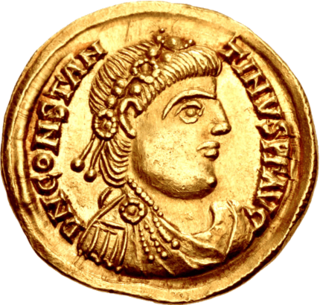
Constantine III was a common Roman soldier who was declared emperor in Roman Britain in 407 and established himself in Gaul. He was recognised as co-emperor of the Roman Empire from 409 until 411.

Jovinus was a Gallo-Roman senator and claimed to be Roman Emperor.

Constans II was the son of Western Roman emperor Constantine III, and served as his co-emperor from 409 to 411. Constans was a monk prior to his father being acclaimed emperor by the army in Britain in early 407, an act of rebellion against the ruling emperor Honorius. He was summoned to Gaul, appointed to the position of caesar (heir) and swiftly married so that a dynasty could be founded. In Hispania, Honorius's relatives rose in 408 and expelled Constantine's administration. An army under the generals Constans and Gerontius was sent to deal with this and Constantine's authority was re-established. Honorius acknowledged Constantine as co-emperor in early 409 and Constantine immediately raised Constans to the position of augustus (emperor), theoretically equal in rank to Honorius as well as to Constantine. Later in 409 Gerontius rebelled, proclaimed his client Maximus emperor and incited barbarian groups in Gaul to rise up. Constans was sent to quash the revolt, but was defeated and withdrew to Arles. In 410, Constans was sent to Hispania again. Gerontius had strengthened his army with barbarians and defeated Constans; the latter withdrew north and was defeated again and killed at Vienne early in 411. Gerontius then besieged Constantine in Arles and killed him.

The fall of the Western Roman Empire, also called the fall of the Roman Empire or the fall of Rome, was the loss of central political control in the Western Roman Empire, a process in which the Empire failed to enforce its rule, and its vast territory was divided among several successor polities. The Roman Empire lost the strengths that had allowed it to exercise effective control over its Western provinces; modern historians posit factors including the effectiveness and numbers of the army, the health and numbers of the Roman population, the strength of the economy, the competence of the emperors, the internal struggles for power, the religious changes of the period, and the efficiency of the civil administration. Increasing pressure from invading peoples outside Roman culture also contributed greatly to the collapse. Climatic changes and both endemic and epidemic disease drove many of these immediate factors. The reasons for the collapse are major subjects of the historiography of the ancient world and they inform much modern discourse on state failure.
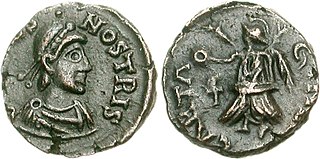
Bonifatius was a Roman general and governor of the diocese of Africa. He campaigned against the Visigoths in Gaul and the Vandals in North Africa. An ally of Galla Placidia, mother and advisor of Valentinian III, Bonifacius engaged in Roman civil wars on her behalf against the generals Felix in 427-429 and Aetius in 432. Although he defeated the latter at the Battle of Rimini, Bonifacius suffered a fatal wound and was succeeded by his son-in-law Sebastianus as patricius of the Western Roman Empire.
Sarus or Saurus was a Gothic chieftain known as a particularly brave and skillful warrior. He became a commander for the Emperor Honorius. He was known for his hostility to the prominent Gothic brothers-in-law Alaric I and Athaulf, and was the brother of Sigeric, who briefly ruled the Goths in 415.

The Gothic revolt of Theodoric I was an uprising of the Gothic Foederati in Aquitaine during the regime of Emperor Valentinian III (425-455). That rebellion was led by Theodoric I, King of the Visigoths and took place in the South of France. The uprising took place between 425 and 426, in the period shortly after the death of usurpator John and was terminated by a military operation under the command of Aëtius.

The Bagaudae Revolt (409-417) was a violent conflict in the early 5th century, involving part of the population in northwestern Gaul. The uprising was an indirect result of the Rhine crossing in 405–406, through which various Germanic peoples invaded the Western Roman Empire, as well as the revolt of the army in Britannia and the resulting civil war. In the following period, the Gallic population largely had to rely on itself and formed self-defense groups, which were called Bagaudae. In mid-409, groups of Bagaudae in the Loire Valley and Brittany rebelled against the Roman regime. The course of this uprising has been briefly reported. Most of the information comes from the work of the Byzantine historian Zosimus (460-515), the Roman poet Rutilus Namatianus and the priest Salvianus from Marseille.
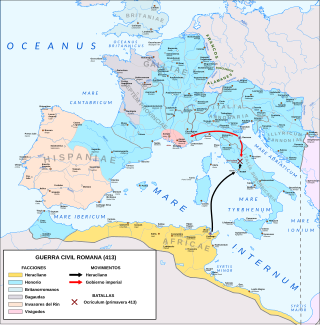
The War of Heraclianus was a short military conflict in 412–413, between the imperial generals Heraclianus and Constantius III, in a period known for being very turbulent and violent. There were a large number of uprisings in the Western Roman Empire and various groups of barbarian tribes crossed the empire. The conflict between Heraclianus and Constantius can be seen as one of many links in the chain of events that set in motion the downfall of the Roman Empire. In the conflict, Constantius remained loyal to the emperor and Heraclian tried to become emperor of the empire himself.

The Gothic War in Spain was a military operation of the Visigoths commissioned by the West Roman Empire. This operation consisted of multiple campaigns that took place between 416 and 418 and were directed against the Vandals and the Alans to restore Roman power in the Spanish provinces of Betica, Lusitania and Cartaginense. As far as is known, the Roman field army was not involved in the battles, only foederati units fought on the side of the Romans. According to Thompson the Hasdingi in Gallaecia played a dubious role in this war.
References
- ↑ Patrick J. Geary, ed., Readings in Medieval History (Ontario: Broadview Press Ltd., 2003), 97.
- ↑ Henry Bradley, The Goths: from the Earliest Times to the End of the Gothic Dominion in Spain (New York: G.P. Putnam's Sons, Second edition, 1883), chapter 11.
- ↑ "within that period he developed from a tribal chief to a late antique statesman." Herwig Wolfram, History of the Goths (1979, tr. 1988) p. 164.
- ↑ Heather, Peter (1991). Goths and Romans: 332-489. Oxford: Clarendon Press. p. 198.
- ↑ Jordanes, Historia Gothorum, XXXI.
- ↑ Orosius, Historiae adversum paganos (vii.43.4-6), translated in Stephen Williams, Diocletian and the Roman Recovery, Routledge, 1985, 2000, p. 218)
- ↑ "Review of: Silver and Society in Late Antiquity. Functions and Meanings of Silver Plate in the Fourth to the Seventh Centuries". Bryn Mawr Classical Review.
- ↑ Antonio Marchetta, Orosio e Athaulfo nell'ideologia dei rapporti romano-barbarici (Rome: Istituto Isorico per il Medio Evo) 1987. The first chapter deals with the doubts raised by previous historians as to the authenticity of the discourse.